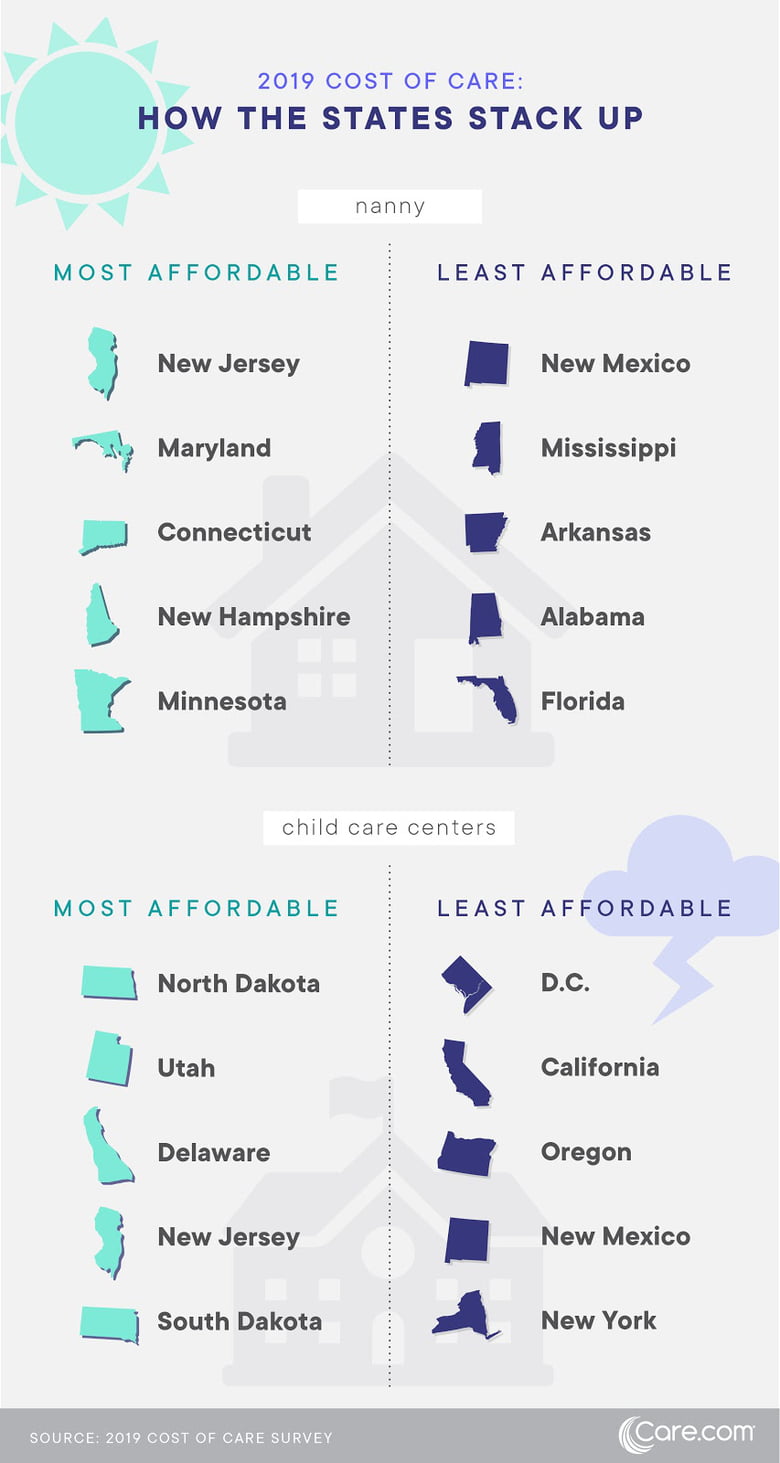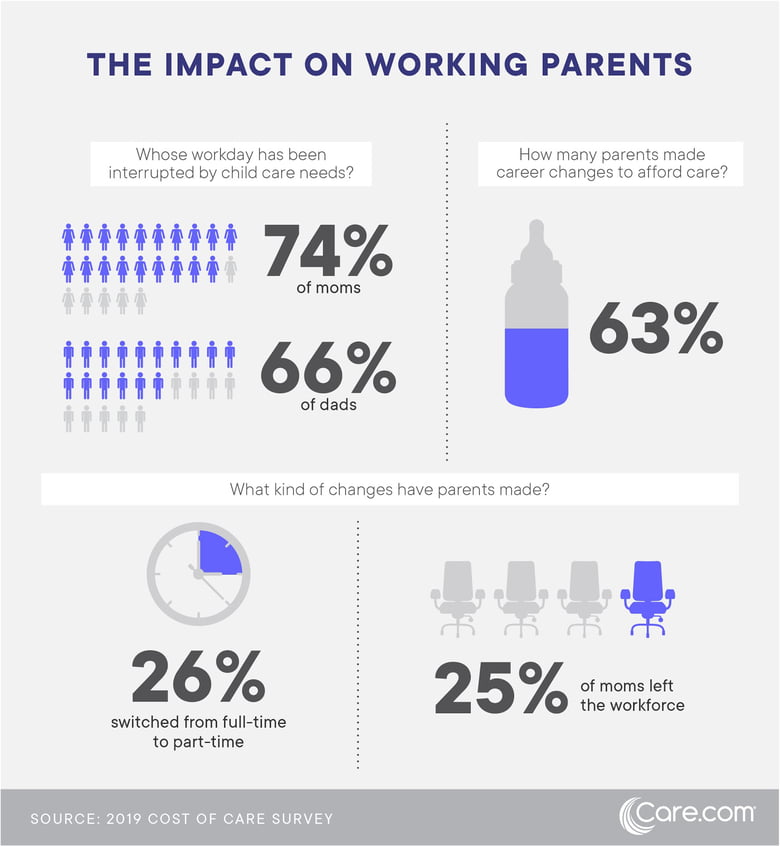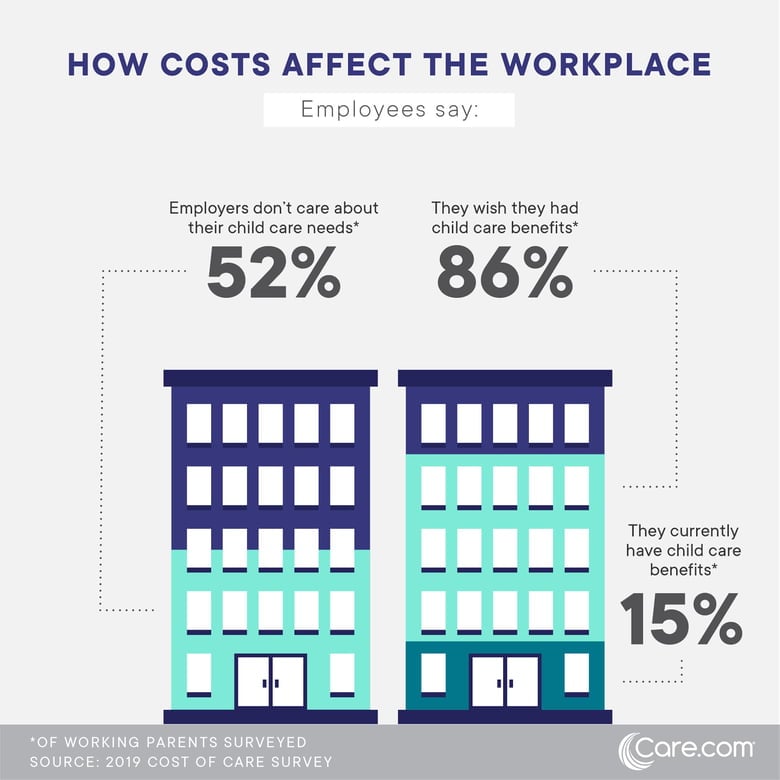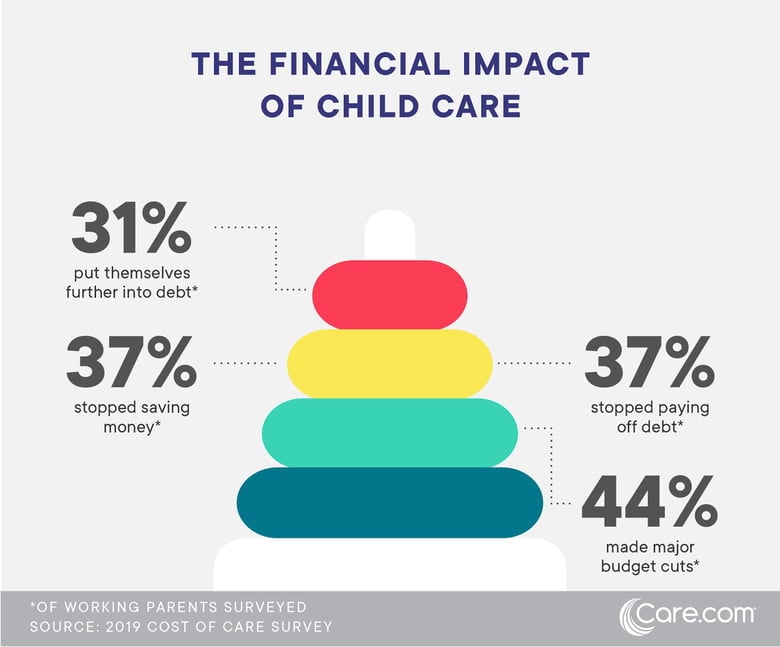Read the Care.com 2023 Cost of Care Report: This is what child care costs in 2023
The rising cost of after-school sitters, day care, nannies and other child care is claiming an ever-growing portion of the American family budget this year, according to the Care.com 2019 Cost of Care survey
The sixth annual survey, compiled with insights from more than 4,000 parents nationwide about their child care spending, showed the intense squeeze that child care is putting on the family wallet:
- For the second consecutive year, over 70% of families reported paying more than 10% of their income on care, while the U.S. government defines “affordable care” as no more than 7% of family income.
- In fact, more than 40% of families spend more than 15% of household income on care.
- Two-thirds of parents say they’re spending more on child care than they did last year.
The survey also asked parents how they’re responding to the rising cost of child care. More families than ever before told Care.com they’re budgeting for child care: 84%, up from 68% last year and from 54% five years ago. However, that figure masks a deepening crisis. While 70% of families say they’re able to afford their current care arrangement, the details of how they make it work tell a more complicated story: American families say they are not only saving less, working less and spending less, but they are also having fewer children.
The survey results demonstrate the central role that care plays in our economy, and the new data helps illuminate why child care is taking center stage in American politics and policy. Lawmakers from both parties have recently unveiled ambitious new proposals to help fix America’s broken child care system.
Measuring the impact of child care costs on families, businesses and the economy is a key first step to solving America’s care crisis. Let’s look at some of the ways the rising costs of child care is having a significant impact on families, employers and the economy. Four families with children also share with us their child care situations and actual monthly budgets so we can see how child care fits (or doesn’t) into their monthly spending.
What is the cost of child care around the country?
Child care is less affordable for families than it was a year ago, according to the Care.com survey, which showed the cost of care increased last year for two-thirds of families. According to Care.com data, the average weekly child care cost for one infant child is $199 for a family care center, $211 for a day care center (also referred as “child care centers”) and $596 for a nanny.
Interactive: Use our Cost of Child Care Calculator to find the cost of different child care options near you.
Below are the national averages of weekly child care costs for each type of care, mapped over the past six years.
National Average Weekly Rates*
| 2018 | 2017 | 2016 | 2015 | 2014** | 2013** | |
| Nanny | $596 | $580 | $565 | $557 | $477 | $472 |
| After-School | $244 | $242 | $232 | $214 | $197 | $181 |
| Child Care Center | $213 | $211 | $211 | $196 | $188 | $186 |
| Family Care Center | $199 | $195 | $200 | $181 | $140 | $127 |
| Au Pair | $390 | $390 | $367 | $360 | $360 | $360 |
* All rates are for one infant child, except for After-School Sitter, which is not age limited.
** All 2013 and 2014 figures were based off the national data from Child Care Aware.
Of course, child care costs can vary depending on a number of different factors, including the type and quality of care provided and the city and state where you live.
What are the most affordable states for child care in 2019?
Top five most affordable states to hire a nanny:***
- New Jersey
- Maryland
- Connecticut
- New Hampshire
- Minnesota
Top five most affordable states to use a child care center***
- North Dakota
- Utah
- Delaware
- New Jersey
- South Dakota
What are the least affordable states for child care in 2019?
Top five least affordable states to hire a nanny***
- New Mexico
- Mississippi
- Arkansas
- Alabama
- Florida
Top five least affordable states to use a child care center***
- District of Columbia
- California
- Oregon
- New Mexico
- New York
*** Based on the average cost of care in relation to the state median family income among households with children.

What’s the impact on working parents?
According to the survey findings, a full 70% of respondents said the cost of child care was the No. 1 cost that surprised them upon starting a family.
Two-thirds of parents said that, prior to having children, they did not expect the cost of child care would influence their career decisions, but survey responses revealed quite the opposite:
- 63%, nearly the same share of respondents, said they made career/workplace changes in order to afford child care. Common career moves included:
- Changing jobs for higher pay (38%)
- Asking for a more flexible schedule (36%)
- Switching from full-time to part-time schedule to save money on child care (26%)
- Moms especially felt the impact of care challenges on their careers:
- More than half of moms scaled back their hours to save on child care
- 25% of moms left the workforce altogether
- In hindsight, too, 22% of parents say they regret the concessions they’ve made in their careers to take on unpaid care responsibilities.
A mom of two in Los Angeles admits to Care.com that she squeezes a five-day workweek into the two days a week that a nanny comes to watch her youngest. This largely unsustainable strategy puts a major burden on Mom, which can only trickle down to the rest of the family.
Another mom of two from a Minneapolis suburb tells Care.com that when she explained to her supervisor that she would have to pay more to pick up her children from day care after 4:30, she learned she could work flexible hours and even from home on occasion. “My boss doesn’t watch the clock,” she says. While this mom is definitely one of the lucky ones, it still fell to her to negotiate an affordable arrangement that worked with both her job and her child care.

What’s the impact on the workplace?
Child care has also had a more direct effect on parents in the workplace:
- 74% of moms and 66% of dads say their workdays have been impacted because child care fell through at the last minute.
- In those situations, 70% have used sick days and more than half (56%) have come in late; one in three moms has lost a day’s pay, while one in four brought their child to work.
- Only about half of parents surveyed (48%) say their employer seems to care about their child care needs.
- Just 15% of working parents say their employer offers benefits like backup child care — but 86% say they wish they did.
Those percentages are consistent with the most recent National Study of Employers, which found that just 7% of companies provide child care at or near the worksite, and only 5% offer backup care for employees when their regular care arrangements fall apart.

What’s the financial and familial impact of child care costs?
Although the Care.com study showed most families are spending well over the government’s affordability benchmark, 70% of respondents said they’re able to afford their current child care plan. But how are families making ends meet? An all-time high cohort of parents, 84%, said they budget for child care. By that, it turns out, they mean they’re spending less on everything else:
- 31% said they’d put themselves further into debt.
- 37% stopped saving money.
- 37% stopped paying off debt.
- 44% made major budget cuts.
- 41% reduced non-child related household expenses, like eliminating gym memberships or cutting the cord on cable.
The survey also asked parents how they’re impacted, in addition to financial strain, by the rising cost of child care:
- 36% say child care costs have caused relationship tension.
- 39% say care costs have impacted family planning.
- 39% say they waited longer to have children or had fewer children than they would have liked because of the high cost of care.
According to one family in Dallas, Texas, who spoke to Care.com, the cost of care absolutely affected their family planning. “We only had one child for the first nearly seven years, so only having one day care payment was a lot easier to withstand versus if we had multiple children close together,” explains the mom, who is now pregnant with Baby No. 2.
With the ongoing demand for dual incomes and the high cost of child care, adult relationships can take a back burner too. “Our honeymoon was the first time in four and a half years that we were able to spend more than two days together without work or a child,” one stepmom of one in Thornton, Colorado tells Care.com.

What can parents do to reduce the cost of care?
While 73% of parents found child care costs were higher than they expected, there are several ways to mitigate the costs.
- Do your research. Once you know how much you can afford, you can pinpoint the most feasible child care option by researching current rates in your area with free interactive tools, like babysitter rates and nanny tax calculators.
- The survey found only 1 in 4 parents actually contribute to a Flexible Spending Account (FSA). Most employers offer an FSA, which can include up to $5,000 before taxes and covers day care, preschool and nannies, ultimately helping families save up to $2,300 per year.
- Take advantage of tax breaks made available to you by paying your caregiver above board. Beyond giving caregivers access to professional benefits, like Social Security and Workers’ Compensation, families can save $600 with one child and $1,200 with two or more children.
- Look into child care subsidies and programs for which your family may qualify.
About the Care.com 2019 Cost of Care data
The Cost of Care survey is an annual survey to measure the relative cost of child care in the U.S. and how care impacts families’ budgets and employment. The Care.com 2019 Cost of Care survey captured responses from 4,146 parents in the United States during the month of April 2019. Respondents were recruited from Care.com.
Weekly rates for a nanny and after-school sitter are based on Care.com 2018 member data, child care center and family care center rates are based on rate information from centers listed on Care.com, and au pair rates are based on data from Cultural Care Au Pair, Au Pair in America and Au Pair Care. Affordability rankings are calculated based on the average cost of care in relation to the U.S. Census Bureau’s 2016 American Community Survey that includes the state median family income of households with children.
Employers interested in learning how to best support their working families can visit care.com/careatwork.
The 2019 real cost of care interviews with families:
- Two parents in Dallas, Texas, with 1.5 kids
- Two parents in Thornton, Colorado, with 1 kid
- Two parents in a Minneapolis suburb, with 2 kids
- Two parents in Los Angeles, with 2 kids




